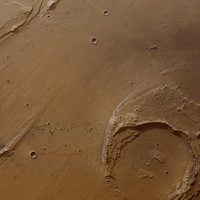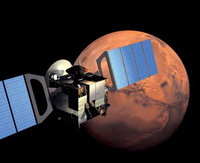Archive
Earth’s Magnetic Field Provides Vital Protection
A chance alignment of planets during a passing gust of the solar wind has allowed scientists to compare the protective effects of Earth’s magnetic field with that of Mars’ naked atmosphere. The result is clear: Earth’s magnetic field is vital for keeping our atmosphere in place.
The alignment took place on 6 January 2008. Using ESA’s Cluster and Mars Express missions to provide data from Earth and Mars, respectively, scientists compared the loss of oxygen from the two planets’ atmospheres as the same stream of solar wind hit them. This allowed a direct evaluation of the effectiveness of Earth’s magnetic field in protecting our atmosphere.
They found that while the pressure of the solar wind increased at each planet by similar amounts, the increase in the rate of loss of martian oxygen was ten times that of Earth’s increase.
Such a difference would have a dramatic impact over billions of years, leading to large losses of the martian atmosphere, perhaps explaining or at least contributing to its current tenuous state.
Full Story: http://www.esa.int/esaSC/SEMXWW7YBZG_index_0.html
Mars Express Radar Gives Strong Evidence for Former Ocean
ESA’s Mars Express has returned strong evidence for an ocean once covering part of Mars. Using radar, it has detected sediments reminiscent of an ocean floor within the boundaries of previously identified, ancient shorelines on Mars.
The MARSIS radar was deployed in 2005 and has been collecting data ever since. Jérémie Mouginot, Institut de Planétologie et d’Astrophysique de Grenoble (IPAG) and the University of California, Irvine, and colleagues have analysed more than two years of data and found that the northern plains are covered in low-density material.
“We interpret these as sedimentary deposits, maybe ice-rich,” says Dr Mouginot. “It is a strong new indication that there was once an ocean here.”
Full Story: http://www.esa.int/export/esaSC/SEMVINVX7YG_index_0.html
Mars Rover to Spend Winter at ‘Greeley Haven’
NASA’s Mars Exploration Rover Opportunity will spend the next few months during the coldest part of Martian winter at Greeley Haven, an outcrop of rock on Mars recently named informally to honor ASU Regents’ Professor Ronald Greeley, a planetary geology who died Oct. 27, 2011.
Long passionate about exploring the solar system and Mars in particular, Greeley was involved with many missions to the Red Planet, including Mariners 6, 7, and 9, Viking, Mars Pathfinder, Mars Global Surveyor, and the two Mars Exploration Rovers. He was also a co-investigator for the camera system on the European Space Agency’s Mars Express orbiter mission. Among his major research interests were wind erosion, dunes, and dust devil activity, all of which can be found in abundance on Mars.
Full Story: http://asunews.asu.edu/20120105_greeley_haven
Clusters of Recent Craters in Mars’s Ares Vallis
Newly released images taken by ESA’s Mars Express show an unusual accumulation of young craters in the large outflow channel called Ares Vallis. Older craters have been reduced to ghostly outlines by the scouring effects of ancient water.
In the distant past, probably over 3.8 billion years ago, large volumes of water must have rushed through the Ares Vallis with considerable force. Mars Express imaged the preserved aftermath of this scene on 11 May 2011.
The prominent Oraibi crater lies in the channel and is about 32 km across. It is filled with sediments and its southern rim has been eroded by water. NASA’s Pathfinder mission landed in this region in 1997, 100 km to the north of the crater and off the right-hand side of this image.
Full Story: http://www.esa.int/export/esaSC/SEMGJB9U7TG_index_0.html
ESA Orbiter Discovers Water Supersaturation in the Martian Atmosphere
New analysis of data sent back by the SPICAM spectrometer on board ESA’s Mars Express spacecraft has revealed for the first time that the planet’s atmosphere is supersaturated with water vapour. This surprising discovery has major implications for understanding the Martian water cycle and the historical evolution of the atmosphere.
Although numerous spacecraft have visited Mars over the past half a century, very few direct measurements of the vertical structure of the planet’s atmosphere have been made. Since most of the spacecraft instruments have looked down at the surface, it has only been possible to infer the horizontal distribution of gases in the atmosphere, leaving the question of how water vapour is being mixed into the atmosphere almost unexplored.
This lack of direct measurements has meant that descriptions of the vertical distribution of water vapour — a key factor in the study of Mars’ hydrological cycle — has generally been based upon global climate models.
Full Story: http://sci.esa.int/science-e/www/object/index.cfm?fobjectid=49342


